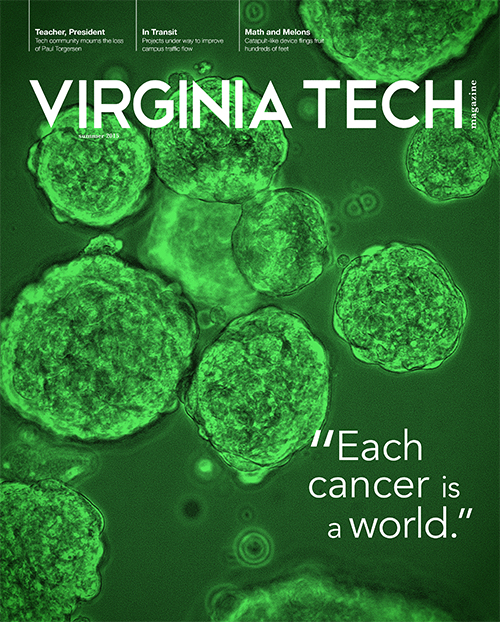Virginia Tech Magazine explores the fight against cancer, remembers the late President Emeritus Paul Torgersen

Because cancer takes many forms, each unique to itself, Virginia Tech faculty, students, and alumni who fight the disease find themselves in a wide variety of roles.
In its summer 2015 edition, Virginia Tech Magazine showcases the university's efforts to fight cancer. Whether through caregiving, research, or fundraising, Hokies infuse their work with the spirit of Ut Prosim (That I May Serve) to battle cancer at all levels.
The late Paul Torgersen, Virginia Tech's president from 1994 through 2000, left a legacy that is evident in the university's national profile today. Torgersen's life and career are remembered in a story that looks at his lasting impact.
Navigating the Virginia Tech campus soon will be simpler, following construction projects at the north end of the Drillfield, at the Southgate Drive and U.S. Route 460 intersection, and in the northern section of campus near Prices Fork Road and West Campus Drive. Our maps will help bring you up to date and get you where you want to go.
And the latest installment of How Tech Ticks examines a melon-tossing trebuchet, a catapult-like device designed by the Virginia Tech chapter of the Society of American Military Engineers, demonstrating how cadets have learned about and improved their design.
Elsewhere in the magazine, reconfigured Around the Drillfield and Class Notes sections address feedback from our fall 2014 readership survey. In addition, the magazine's website has been redesigned to be more mobile-friendly.
The Web version of Virginia Tech Magazine features online-only multimedia content. Request printed copies by emailing magazine editor Jesse Tuel.
Dedicated to its motto, Ut Prosim (That I May Serve), Virginia Tech takes a hands-on, engaging approach to education, preparing scholars to be leaders in their fields and communities. As the commonwealth’s most comprehensive university and its leading research institution, Virginia Tech offers 240 undergraduate and graduate degree programs to more than 31,000 students and manages a research portfolio of $513 million. The university fulfills its land-grant mission of transforming knowledge to practice through technological leadership and by fueling economic growth and job creation locally, regionally, and across Virginia.










